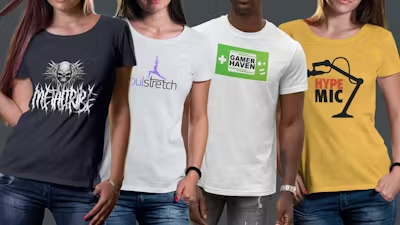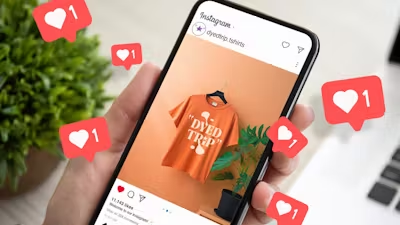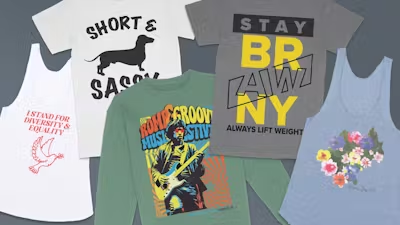Welcome to Chapter 2 of The Ultimate T-Shirt Business Success Guide!
In the fiercely competitive world of t-shirts, planning is your secret weapon, especially with the booming rise of e-commerce and print-on-demand services. Crafting a solid business plan is your blueprint for success and a powerful tool to attract funding or partners. Ready to chart your course to triumph? Let’s dive in!
Table Of Contents
- Executive Summary: What's the big picture?
- Business Description: What Makes Your T-shirt Business Unique?
- Market Research: Who Are You Selling To?
- Operations Plan: How Will Your Business Operate?
- Management and Personnel: Who’s on Your Team?
- Your Product Line: What Are You Selling, Exactly?
- Sales and Marketing Strategy: How Will You Get the Word Out?
- Financial Plan: What's the Outlook?
- Appendices: Got Any Extras?
- Conclusion

Executive summary: What's the big picture?
The executive summary provides a high-level overview of your entire business plan, encapsulating the fundamental details of your t-shirt company. While it's wise to write it after completing your entire plan, it's arguably the most essential. It can be brief–even a paragraph–but should resonate with clarity and have direction and purpose. The summary should clearly and concisely convey the essence of your business:
Company overview: What is your specialty - niche brand or broad selection? What are your core offerings - custom designs, printing methods, collections? What makes you stand out - innovative designs, eco-friendly materials, print quality?
Target market: Who are your ideal customers - millennials, sports fans, corporations? What motivates them - fashion, comfort, personalized designs?
Business model: What is your revenue model - direct sales, subscriptions, third-party resellers, or wholesale orders? What are your main costs?
Competitive landscape: Who are your main competitors? What is your competitive advantage?
Marketing & sales: How will you reach target customers? What are your sales strategies?
Financial projections: What are your 1-3 year revenue, expense, and profit projections?
Mission & vision: What is your company's purpose and direction?
Example executive summary:
Catering to millennials and Gen Z consumers, Alien Mind T-Shirts is a fresh t-shirt business aiming to capture the individuality of young adults through high-quality, unique designs. Our selections will include various original graphic designs in trending colors printed on top-notch materials. Setting us apart from many competitors, we will operate a fully self-managed e-commerce store with an in-house print-on-demand model utilizing direct-to-film (DTF) transfers. This approach gives us control over quality and timeliness. Our multi-channel marketing strategies will span online and offline platforms. Financially, projections are optimistic, with expected revenue growth from 50K in year one to 500K by year three.
Business description: What sets your t-shirt business apart?
Every successful t-shirt company starts with a unique idea and vision. This section is about more than just describing your business; it's about crafting a narrative that captures the true essence of your brand.
Brand origin: Is your brand new or established? Providing this context helps set appropriate positioning and customer expectations.
Name and slogan: What is your memorable name and concise slogan? Developing these elements aids brand recall and conveys the core values of your business.
Offerings: What are your primary products and services? Clearly defining your core offerings ensures you directly meet customer needs. Also, consider ancillary services that could add value for customers.
Unique Value Proposition (UVP): What sets you apart in the market? Why should customers choose you over competitors? Highlighting your differentiation and conveying clear benefits answers this critical question.
Intellectual property: What designs, names, slogans, or techniques will you protect? Safeguarding exclusivity preserves brand value and uniqueness.
Company structure: What company structure and roles will you implement? These choices impact taxation, liability, operations, and public perception.
Sculpting a solid brand identity is crucial for success.

Market research: Who are you selling to?
Thorough market research acts as a compass to guide your business decisions. By closely analyzing the landscape, you identify opportunities and threats to inform strategic planning. Here's how to approach it:
Marketplace analysis: What is the current state of the t-shirt market? Understanding if sales are booming or slow provides context on potential challenges and openings your business may encounter. Consider seasonal market data for a complete picture.
Customer analysis: Who specifically are you selling to, and what are their preferences? Clearly defining your target demographic and crafting an ideal customer persona ensures your offerings resonate.
Competitor analysis: How does your business compare to rivals in the market? Identifying competitors' strengths and weaknesses enables effective positioning of your unique value proposition.
Niche identification: What underserved gap exists that your business can occupy? Locating a niche with less competition elevates your specialty offerings in that space.
Conducting thorough research across these areas provides a holistic view of the market dynamics and your position within it. This context is invaluable for strategic planning.
Operations plan: How will your business operate?
Your operations plan details the daily activities that bring your t-shirt business to life. An initial blueprint streamlines processes, minimizes issues and sets you on a path to success. This overview ensures you consider all facets of your operations, creating a robust foundation:
Business model: What model will you use - bulk printing, print-on-demand, in-house, etc? The model dictates operational needs, costs, and order fulfillment speed.
Location: What is your business base - online, physical store, or both? Location impacts shipping, customer reach, and taxes.
Production process: What is your design for printed t-shirt workflow? Smooth, efficient operations reduce costs, improve quality, and increase speed.
Technology: What tools will you use for design, inventory, marketing, etc? The right tech automates tasks, provides insights, and enhances customer experience.
Inventory management: What system will you use to track and control stock? Effective inventory management reduces costs and optimizes cash flow.
Customer service: Will it be in-house or outsourced? How can customers contact you? Strong service increases loyalty, repeat sales, and brand reputation.
Your chosen business model can influence the t-shirt printing methods you adopt.

Management and personnel: Who's on your team?
The people behind your business drive it forward through expertise, passion, and dedication. Assembling a team with diverse skills, experience, and passion enables a t-shirt business to reach its full potential. Understanding your team composition and roles streamlines operations and highlights strengths.
Team overview: Who comprises your team–solo, partners, or full team? What unique skills does each member have? Recognizing strengths optimizes operations and innovation.
Organizational structure: What are the management roles and hierarchy? What responsibilities does each person own? A clear structure promotes accountability, efficiency, and communication.
Mentors and advisors: Do you have veteran industry experts guiding you? How do they contribute - insights, strategy, funding? Their experience provides direction, connections, and credibility.
Future staffing needs: As you grow, what roles will you need - designers, customer support, logistics? Planning for expansion ensures you can meet increasing demands smoothly.
Businesses cannot succeed without the right people and roles in place. Conducting an honest evaluation of current personnel and planning for future needs ensures your business has the human infrastructure to achieve long-term growth and profitability goals. Your team is your most valuable asset–nurture and organize it wisely.
Your product line: What do you sell exactly?
Your product line represents the core of your t-shirt business. Clearly defining your offerings ensures you meet customer expectations, align with market trends, and set up your business for growth. Consider:
Product types: What styles do you offer - crewnecks, tanks, long sleeves? What is your niche - graphic tees, artistic prints, custom designs? Is your collection limited or vast? Catering to diverse tastes expands your reach, but a niche establishes a specialty.
Quality and position: Do you target the premium, budget-friendly, or mid-range market? Quality affects reputation, satisfaction, and pricing power.
Pricing strategy: Will you use cost-plus, value-based, or competitor pricing? How do your prices compare? Pricing impacts profits and brand perception.
Product lifespan: Do you have seasonal collections or staple evergreen designs? Limited runs create urgency. Understanding lifespan aids inventory and marketing.
Your product line tangibly represents your brand. Ensuring offerings align with your vision and market is pivotal for sustained success.

Sales and marketing strategy: How will you get the word out?
In the business world, even the most fantastic products need proper exposure to thrive. That's where a robust sales and marketing strategy steps in. Think of it as a recipe; each ingredient, from sales channels to advertising mediums, needs to be meticulously chosen and mixed in just the right proportions to create success. Consider each component carefully to optimize results:
The relationship between sales, marketing, and advertising: Understand their interdependence. While sales focus on individual conversions, marketing targets broader audience engagement. Advertising amplifies product visibility. Together, they create a cohesive strategy that propels your business forward.
Sales channels: What diverse platforms will you sell on? E-commerce site, online marketplaces like Etsy, Amazon, physical stores, social media? Choosing the right mix expands reach and caters to varied customer preferences. Different channels provide access to diverse audiences and profit margins.
Pricing approaches: Will you offer seasonal sales, product bundles, subscriptions, or promo codes? Ensure pricing aligns with market trends, competitors, and perceived customer value. Pricing impacts positioning, inventory management, and profitability.
Promotional tactics: What limited-time offers or influencer collaborations will you do? Strategic partnerships tap into new audiences. Effective promotions boost short-term sales, introduce your brand to new customers, and build lasting impressions.
Advertising channels: Will you use traditional media or online platforms? Tailor channels to where your audience is. Strategic selection optimizes returns on advertising spend.
Harmonizing all sales and marketing activities creates a symphony primed for business success.
Financial plan: What's the outlook?
Crafting a rock-solid financial plan may seem dull, but it's crucial for any business's success. Meticulously plotting expenses, sales projections, cash flow, and funding requirements illuminates the path ahead, allowing you to navigate challenges and seize opportunities. With a well-designed financial plan, you can transform your t-shirt business from an idea into reality. The key elements to include:
Defining success metrics: Is success a sales target, profit margin, or reach goal? Establish clear objectives to drive focused efforts and profitability.
Startup costs: What's needed initially - materials, e-commerce platform, marketing? Budget wisely for best returns. Knowing costs prevents financial surprises.
Operating expenses: What's the monthly overhead - rent, salaries, utilities? Find ways to minimize costs without compromising quality. Understanding expenses helps with pricing and sales target setting.
Revenue projections: Based on research and strategy, what are realistic income projections? While dreaming big, ensure estimates are grounded. Projections guide hiring, investments, and growth planning.
Cash flow: Track money in and out to cover expenses and act on opportunities. Positive cash flow enables smooth operations.
Funding requirements: Do projections show a need for more funds? Loans, crowdfunding, or investors can provide capital to accelerate growth and navigate challenges.
Like a t-shirt design evolving from idea to product, a well-crafted financial plan turns your vision into reality. Stay informed, plan thoroughly, track progress, and watch your business flourish.
Appendices: Got any extras?
The appendix provides supporting depth and validation for your t-shirt business plan, similar to behind-the-scenes footage for a movie. While not always in the spotlight, this section lends crucial context, details, and understanding. Use the Appendices to bolster the claims and strategies outlined in your main plan with supplementary data and proofs. Here are some elements to consider, including:
Additional information: You can provide more in-depth data, charts, or images that give deeper insight into points discussed in your primary business plan. This allows readers to explore further interest areas without cluttering the main content.
Certifications or accolades: Any awards, recognitions, or certifications you have received that showcase the excellence of your products or business acumen should be included. This adds credibility to your brand and can be an essential trust factor for potential investors or partners.
Business partnerships or collaborations: Provide details of any alliances with designers, influencers, or other brands. These partnerships can significantly impact your marketing strategies, product development, and revenue streams.
Resumes of key personnel: Give a brief overview of the qualifications, experience, and expertise of your core team members. This provides insight into the human resources backing your business and assures stakeholders of your team's capabilities.
In short, the appendix offers a comprehensive view of your t-shirt business plan and foundations. Transparency and details build trust and credibility, so include anything relevant.

Charting your course to success
As we conclude this chapter, reflect on the journey ahead. Every successful t-shirt business starts with a vision, but meticulous planning and strategic execution drive it forward. A well-crafted business plan is more than a document – it's your treasure map to success in entrepreneurship.
We recommend completing this guide before fully completing your business plan. You may still be considering crucial decisions such as business models and print methods. One promising avenue is the DIY print-on-demand model, where direct-to-film (DTF) transfers shine. With just a heat press, you can bring designs to life.
We explore this topic next in Chapter 3: T-shirt Printing Methods.

































